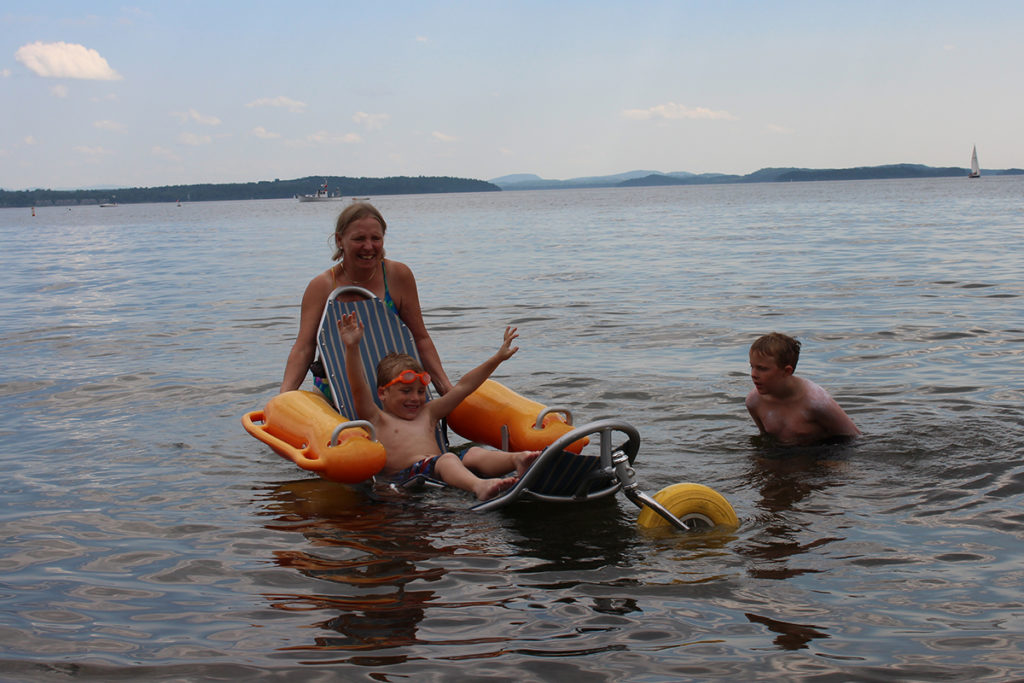Swimming & Accessibility

Swimming and Beach Access with Cerebral Palsy
A guest blog post from Cerebral Palsy Guidance
Enjoying the water in the summer, and having fun at the beach, is something that everyone should be able to enjoy. For someone with physical disabilities, like those that often accompany the condition called cerebral palsy, getting to the beach, let alone getting in the water may seem impossible. There are many beaches and parks though, that offer accessibility for disabled people, including North Beach Park in Burlington, Vermont.
Cerebral Palsy, Disabilities, and Swimming
Not only is swimming a fun activity that many people with physical disabilities may enjoy, it can actually be a beneficial therapy. Cerebral palsy is a neurological disorder that causes physical disabilities in most people born with it. These can range from minor issues, like toe dragging when walking to a complete inability to walk, serious muscle pain, and very limited mobility. With no cure for this condition, various types of physical therapy are important to improving mobility and reducing pain.
One of the great things about being in the water for someone with mobility issues or pain is the buoyance. It allows a person to leave gravity behind and to be able to exercise muscles and move limbs in a way that can’t be done on land. Beyond the practicality of working in the water, swimming and even just floating is fun and refreshing, especially on a hot summer day.

Swimming at North Beach Park
Thanks to the Americans with Disabilities Act of 1990, so many more doors have been opened for people living with disabilities, but there are still some that remain closed. Enjoying the outdoors has remained a challenge for a lot of people who struggle with mobility. Many public parks have made efforts to be inclusive and to improve accessibility, including North Beach, which has active lifeguards on duty in the summer.
Not only does the park have lifeguards to help keep swimmers safe, they also provide an amazing accessibility tool for children and adults who would not otherwise be able to get in the water. The accessibility chair is a large device, with working wheels that also float, as well as other attached flotation devices. The chair can safely hold one person and may be launched from a special mat at the side of the lake. This chair, along with assistance in using it, allows everyone to be able to get in the water and to enjoy the feeling of swimming in the summer.

Stay Safe While Swimming
For anyone with cerebral palsy or other disabilities, swimming can be made possible, but there are also greater safety concerns. If you have a child that would like to try out swimming or playing in the water, there are some important safety factors to keep in mind. Avoid beaches and pools without lifeguards. These professionals are trained to save your child if something goes wrong.
Even with lifeguards on duty, always stay by your child. For a child that has some mobility and will not be using the adaptive chair, provide plenty of safety and flotation devices, such as life vests and swim noodles. Also consider swimming lessons with a professional instructor who has worked with disabled children, so that your child can learn water safety and benefit from greater water mobility.
Cerebral palsy and other disabilities should not hold anyone back from enjoying one of the great joys of summer: being in the water. Going to the beach is fun, but being able to enjoy the water makes a day at the beach truly special.
NOTE: This post content is provided by a guest blogger. The stated author is solely responsible for accuracy and copyright.
